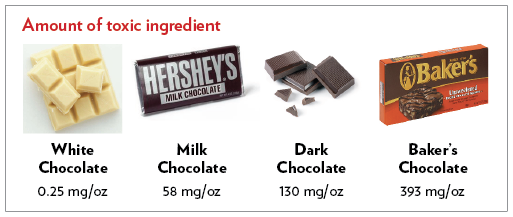
This pet health content was written by a veterinarian, Dr. Debora Lichtenberg, VMD. This article was originally published in 2012, and it has been reviewed for accuracy by Dr. Pippa Elliott, BVMS, MRCVS, and was last updated on June 20, 2024
If you have questions or concerns, call your vet, who is best equipped to ensure the health and well-being of your pet. This article is for informational purposes only and is not a substitute for professional medical advice, diagnosis or treatment. See additional information.

How Much Chocolate is Toxic to Dogs? Golden Rules
As a veterinarian, I get the most calls — by far — during the year-end holiday season (and Easter and Halloween) about chocolate ingestion by pets.
Chocolate can be very toxic to your dog, but the amount and the type of chocolate is critical in assessing whether or not you have to panic.
Below are some golden rules to place on your refrigerator while you’re waiting for your vet to call back. With this information, maybe you don’t have to panic at all:
Rule #1: Estimating Your Dog’s Weight and Chocolate Consumption
With any poisoning or toxicity question, it’s crucial to know your pet’s approximate weight and have a good estimate of how much of the toxin your pet may have eaten.
- Try to round your dog’s weight to the nearest 10 pounds: 20, 50, 100 pounds, etc.
- Get the best idea of the most chocolate your dog could have eaten, such as:
- Three 16-ounce bags of peanut M&M’s
- 4 ounces of dark chocolate
If you ever have to make a call to a pet poison hotline, it’s almost a waste of money if you don’t have a general idea of the amount of the offending substance.
Rule #2: Determining the Type of Chocolate
The type of chocolate is critical in assessing the level of toxicity. The darker the chocolate, the more toxic it is:
- Baker’s chocolate is highly toxic.
- White chocolate is almost nontoxic.
Understanding How Much Chocolate is Toxic for Dogs
Different types of chocolate have varying levels of toxicity for dogs. Here’s a breakdown of how much chocolate can be toxic based on your dog’s weight:
Baking chocolate:
- 0.5 ounce for a 10-pound dog
- 1 ounce for a 20-pound dog
- 1.5 ounces for a 30-pound dog
- Brands include Baker’s Chocolate, Callebaut, Ghirardelli, Guittard, Lindt, Menier, Scharffen Berger, and Valrhona.
Dark chocolate:
- 1.5 ounces for a 10-pound dog
- 3 ounces for a 20-pound dog
- 4.5 ounces for a 30-pound dog
Milk chocolate:
- 3.5 ounces (more than 2 regular Hershey’s Milk Chocolate Bars) for a 10-pound dog
- 7 ounces for a 20-pound dog
- 10.5 ounces for a 30-pound dog
- Brands include M&M’s, Hershey’s, Mars, Kit Kat, Dove, Cadbury, Toblerone, Kinder, Ferrero Rocher, and Galaxy. Semi-sweet chocolate has similar toxicity.
White chocolate:
- It is all but impossible for a dog to overdose on white chocolate.
- 47 pounds of white chocolate for a 10-pound dog
- 95 pounds of white chocolate for a 20-pound dog
- 145 pounds (!) of white chocolate for a 30-pound dog
The “Formula”
If you’re mathematically inclined, you can follow this formula to get a good idea of the level of chocolate toxicity. You need to convert the chocolate into its toxic form. If your dog ingests an amount close to 20 mg or more of toxic ingredient per pound of dog, you need to call the vet right away.

To illustrate the math, let’s say you have a 20-pound dog. We’ll call her Cookie.
- Example 1: Cookie has eaten 3 ounces of dark chocolate. Dark chocolate contains 130 mg/oz of toxin. So, 3 oz x 130 mg divided by 20 pounds of dog weight = 19.5. Is this a worrisome amount for Cookie? Yes, it’s very close to 20. You should call the vet or bring the pet to the emergency hospital. Remember, anything close to 20 or above is an emergency.
- Example 2: What if this was 3 ounces of milk chocolate? Let’s do the math: 3 oz x 58 mg divided by 20 pounds of dog weight = 8.7. You are not anywhere close to the toxic “magic number” of 20. You can relax.
Many of my clients panic when their dog eats a few M&M’s or some chocolate brownies. Neither of these products is solid chocolate, so the amount of chocolate ingested is much less and therefore less toxic. The pet may still get an upset stomach or diarrhea, but you won’t have to worry about bringing them to the emergency hospital.

Emergency Case: Assessing Chocolate-Covered Cherries Incident
An emergency call came in about dogs eating chocolate-covered cherries. Here are the details:
- Dogs’ weights: 60 and 40 pounds.
- Amount consumed: 8 ounces of chocolate-covered cherries.
To determine if this is a toxic amount, let’s do the math. Assuming the smaller dog ate the entire box, which contains milk chocolate:
- 8 ounces x 58 mg of toxin per ounce = 464 mg.
- 464 mg divided by 40 pounds = 11.6 mg/pound.
Since 11.6 mg/pound is below the toxic threshold of 20 mg/pound, there is no immediate cause for concern. The owner can monitor the dogs but doesn’t need to panic.
What to Do If Your Dog Eats Chocolate
f your dog eats chocolate, it’s essential to act quickly and follow these steps:
- Determine the Amount and Type of Chocolate:
- Type of chocolate: Dark, milk, and baking chocolate are more toxic than white chocolate.
- Amount consumed: Estimate how much your dog ate.
- Calculate the Toxic Dose:
- Use the formula: Amount of chocolate (oz)×Toxin concentration (mg/oz)÷Dog’s weight (lbs)\text{Amount of chocolate (oz)} \times \text{Toxin concentration (mg/oz)} \div \text{Dog’s weight (lbs)}Amount of chocolate (oz)×Toxin concentration (mg/oz)÷Dog’s weight (lbs).
- If the result is close to or exceeds 20 mg of toxin per pound of your dog’s weight, it’s an emergency.
- Monitor for Symptoms:
- Common symptoms include vomiting, diarrhea, rapid breathing, increased heart rate, and seizures.
- Contact your vet if you notice any of these symptoms or if you’re unsure about the severity.
- Contact a Veterinarian:
- Provide details about your dog’s weight, the type and amount of chocolate consumed, and any symptoms observed.
- Follow the vet’s advice, which may include bringing your dog in for an examination or inducing vomiting at home.
- Prevent Future Incidents:
- Store chocolate and other toxic foods out of reach.
- Educate family members about the dangers of chocolate to pets.
By taking these steps promptly, you can help ensure your dog’s safety and well-being.
References
- Gwaltney-Brant, Sharon M., DVM, PhD, DABVT, DABT. “Chocolate.” Merck Veterinary Manual. https://www.merckvetmanual.com/toxicology/food-hazards/chocolate.
- Peterson, Michael E., DVM, and Patricia A. Talcott, MS, DVM, PhD, DABVT. Small Animal Toxicology. Elsevier Health Sciences. 2013. 648–651.
- Zoumas, B.L., Kreiser, W.R, and Martin, R.A. “Theobromine and caffeine content of chocolate products.” Journal of Food Science. 45:314, 1980.
- American Kennel Club. “What to Do If Your Dog Ate Chocolate.” https://www.akc.org/expert-advice/health/what-to-do-if-your-dog-ate-chocolate.


